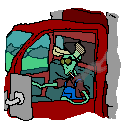|
In the Boston area they have many "rotaries", although they usually are much bigger than a roundabout.
|
|
|
|

|
| # ? May 15, 2024 19:59 |
|
Cichlidae posted:I've got to try setting up a no-exit roundabout one of these days, just to see how people react. Someplace low-volume. I'd just stand there, cones blocking the exits, waving people around for one victory lap after another... Tell me where you're doing this, I'll drive from MA and film it.
|
|
|
|
Grand Fromage posted:Where are you from? Here they call roundabouts rotaries, and no one I've talked to has ever heard of that anywhere else. We figured it was some weird Korean mistranslation but now I'm wondering if they took it from where you live. Massachusetts calls their old traffic circles rotaries; the most famous of which for out-of-staters is the Cape Cod Rotary. Elendil004 posted:Tell me where you're doing this, I'll drive from MA and film it. But you might never find the way back home!
|
|
|
|
Cichlidae posted:Massachusetts calls their old traffic circles rotaries; the most famous of which for out-of-staters is the Cape Cod Rotary. That is the rotary she was stuck on asking if she should turn right to leave! Also, I was a professional navigator, I think I could handle your worst VSSIM induced cone-nightmare...
|
|
|
|
The distinction between a rotary and roundabout is kind of pithy but it is important. A roundabout is meant to slow you down significantly, you are forced to stop or slow to a near-stop before entering and traffic is often 20 MPH or less. They're often geometrically very small. On the other hand, a rotary is a large traffic circle that can be entered at-speed, provided there's no other traffic in the rotary If nobody's coming, you don't have to stop or slow. Cars entering the rotary must yield to traffic already in the rotary, otherwise you can just blast through at full speed. Rotaries are often large and were used as freeway interchanges for some god forsaken reason during most of Massachusetts 1950s highway buildup. The rotaries on each end of the Sagamore and Bourne bridges connecting Cape Cod and the mainland are good examples. There's three in a row on Route 5 in West Springfield, for instance.
|
|
|
|
As a Masshole, I genuinely like our old-school terror-circles.
|
|
|
|
Airconswitch posted:As a Masshole, I genuinely like our old-school terror-circles. We had a couple traffic circles spring up on our older freeways but they got replaced with A4s.
|
|
|
|
Airconswitch posted:As a Masshole, I genuinely like our old-school terror-circles. I too enjoy playing a game of chicken with my fellow motorists. Or sitting in traffic trying to go to the Cape. Either way.
|
|
|
|
kefkafloyd posted:I too enjoy playing a game of chicken with my fellow motorists. Or sitting in traffic trying to go to the Cape. Either way. At least they got rid of the northern rotary. Honestly, I'm rather pleased that Cape Cod hasn't bowed to development. They'd be Long Island Lite. That, and I can still make people jealous with a Cape Cod Tunnel resident permit.
|
|
|
|
Cichlidae posted:At least they got rid of the northern rotary. Honestly, I'm rather pleased that Cape Cod hasn't bowed to development. They'd be Long Island Lite. That, and I can still make people jealous with a Cape Cod Tunnel resident permit. I see getting rid of them as more of a safety/evacuation issue. The day the rotary at the end of the Bourne bridge is eliminated will be a very happy day indeed, but I don't think it'll happen for decades. Admittedly almost every time I'm going to the Cape is to go to Falmouth so I predominantly favor the Bourne bridge. Sagamore's a lot better these days.
|
|
|
|
Cichlidae posted:At least they got rid of the northern rotary. Honestly, I'm rather pleased that Cape Cod hasn't bowed to development. They'd be Long Island Lite. That, and I can still make people jealous with a Cape Cod Tunnel resident permit. You're still using the tunnel? C'mon man get with the times...I cant find a picture but I've had a Cape Cod Canal Jump Permit since I moved here...
|
|
|
|
I remember hearing once that stop signs were only 'legal' if they also had stop lines on the ground. Confirm/deny? (In MA if it matters).
|
|
|
|
Hey I have a question that may have been visited earlier in the thread but gosh it's just so long now What is the deal with the big dumb iron plates that are left in place for ~ a week on the road every now and then? Are they protecting a plug of concrete/asphalt while it cures? One of the main cross streets here has just a horrific number of manhole covers and joints that are all screwed up, and it seems like there is a perpetual procession of these big iron plates in one place or another as the city tries to bandaid the problems (my god, just shut down the goddamn road already). They build up little ridges of asphalt around them to maybe try and protect against them popping tires with sharp edges, but I still cringe when I drive to class.
|
|
|
|
Elendil004 posted:I remember hearing once that stop signs were only 'legal' if they also had stop lines on the ground. Confirm/deny? (In MA if it matters). http://www.mhd.state.ma.us/safetytoolbox/downloads/StopSigns.pdf Given that the language concerning stop bars is "may" not "shall", I'd say that you are either misremembering, or whoever told you was full of poo poo. Stew Man Chew posted:Hey I have a question that may have been visited earlier in the thread but gosh it's just so long now I think those are usually put over trenches.
|
|
|
|
Stew Man Chew posted:Hey I have a question that may have been visited earlier in the thread but gosh it's just so long now Let me guess - Kansas City! They do that because our water lines are so loving old that they know they're going to be out in 3 months to dig it back up and patch it again, so they just leave the trench open because it's easier than filling, paving, cutting, excavating, clearing, fixing, filling, and paving again 3 months later. What they really need to do is build the road out of discrete slabs of concrete that can be lifted out for utility service and dropped back in place over an open trench, but I don't know of anyone who's working on a pavement system like that.
|
|
|
|
Chaos Motor posted:What they really need to do is build the road out of discrete slabs of concrete that can be lifted out for utility service and dropped back in place over an open trench, but I don't know of anyone who's working on a pavement system like that. There was a kickstarter for some dude doing just that with pre-cast road pieces several tens of pages ago, but I still maintain it's not a good idea in the long run. Settling, erosion and frost heave would quickly misalign the edges, making that kind of street terrible to drive.
|
|
|
|
Elendil004 posted:I remember hearing once that stop signs were only 'legal' if they also had stop lines on the ground. Confirm/deny? (In MA if it matters). The MUTCD says pretty clearly that it's the line that's optional. The sign is what's important. Additionally, according to the MUTCD, you don't have to stop AT the sign. On the other hand, Rhode Island's state regs require that the front of your car stops at the post, which is pretty dumb considering that sign placement isn't a concrete thing. Stew Man Chew posted:What is the deal with the big dumb iron plates that are left in place for ~ a week on the road every now and then? Are they protecting a plug of concrete/asphalt while it cures? As noted, they're placed over trenches / gaps in the pavement. We try to avoid them if at all possible, because they're a huge hazard to motorcycles and can also be very loud. Plates aren't compatible with plows, for obvious reasons. Jasper Tin Neck posted:There was a kickstarter for some dude doing just that with pre-cast road pieces several tens of pages ago, but I still maintain it's not a good idea in the long run. Settling, erosion and frost heave would quickly misalign the edges, making that kind of street terrible to drive. That can be avoided, or at least abated, with a good sub-base. The costs go up, for sure, but it's not like there aren't any good concrete roads out there. Heck, many of our freeways in New England are concrete under the asphalt.
|
|
|
|
Chaos Motor posted:Let me guess - Kansas City! I'm actually in Columbia SC, but I recall them talking about doing water line work. It just seems like they basically move the plates up and down the street over a year's time period, never really finishing any one section. Meanwhile the rest of the street falls into disrepair. It's incredibly aggravating.
|
|
|
|
Jasper Tin Neck posted:There was a kickstarter for some dude doing just that with pre-cast road pieces several tens of pages ago, but I still maintain it's not a good idea in the long run. Settling, erosion and frost heave would quickly misalign the edges, making that kind of street terrible to drive. I'm being a smart rear end, man. That's my project. Kickstarter was just a shot at "free" money before we started raising actual funds. I didn't admit to my involvement when I posted it because I wanted honest opinions, not 'nice' ones. I don't like 'nice' opinions. But gently caress it, I've mentioned it enough that I may as well admit to it. If you don't believe me check my AYB page with my pictures, same guy as in the video. Hi!  We have removable fasteners between each face of the slab, similar in profile to existing doweled joints except that it's a bolt with a bit of float on it in the longitudinal plane for cold weather contraction. In order to disrupt the pavement surface you'd have to damage 60% of the slab base and shear through the bolt(s) holding it in alignment (which is a major task unless that portion is completely unsupported). Also, heave is mitigated through the agg & milled asphalt base. Cichlidae posted:That can be avoided, or at least abated, with a good sub-base. The costs go up, for sure, but it's not like there aren't any good concrete roads out there. Heck, many of our freeways in New England are concrete under the asphalt. Yeah existing standard is 4" agg, 4" milled asphalt for highways, we're speccing an average of 2" each for a type 3 pavement but specific site conditions will bear on this too. Often times the owner will have a big say in it. The joint work also maintains slab to slab leveling, they'd only be floating for a type 1 pavement at most and preferably not even there. Of course no solid joint means much more intensive base prep, so it is generally a savings to spend the extra on the hardware and avoid the labor. Stew Man Chew posted:I'm actually in Columbia SC, but I recall them talking about doing water line work. It just seems like they basically move the plates up and down the street over a year's time period, never really finishing any one section. The average is that you'll have a new utility access within 6' within 6 months. So they're just shuffling the cards around until they can afford to fix the whole shebang in one go and then repave it properly. Which means it'll be like that for years.
|
|
|
|
While you're here, I found something else that might complicate concrete pavement here. Our newest specs require a 50-mil groove underneath all pavement markings, to improve their longevity. Problem is, if you ever want to change the markings, you have to somehow fill in the old groove, or mill out around it. On asphalt, it's not a big deal, because it's getting repaved in 10 years. How would concrete pavement handle that?
|
|
|
|
Cichlidae posted:On the other hand, Rhode Island's state regs require that the front of your car stops at the post, which is pretty dumb considering that sign placement isn't a concrete thing. Here in Massachusetts the regulation is that you stop at the line or the sign (if the line's not there), carefully pull forward to where you can see traffic coming from both directions, then stop again before continuing onward. It's a pretty good idea, but in practice it leads to people either overshooting the sign or stopping there and then blindly pulling out and risking a T-bone.
|
|
|
|
Cichlidae posted:While you're here, I found something else that might complicate concrete pavement here. Our newest specs require a 50-mil groove underneath all pavement markings, to improve their longevity. Problem is, if you ever want to change the markings, you have to somehow fill in the old groove, or mill out around it. On asphalt, it's not a big deal, because it's getting repaved in 10 years. How would concrete pavement handle that? They have that groove in there because without it, snow plows will just peel the latex(?) marking right off. I'm sure you know that, I'm just explaining for the audience. Installing the groove at the factory is no problem, neither is coloring the concrete through so that there's no actual separate marking strip needed. The problem with these remains in changing the markings, though. If it's pre-grooved, that implies it needs either field service for changes, or a swap for a slab with a different groove (which isn't actually that expensive to do, about the same price as having guys come out and re-apply the normal markings). If it's permanently marked, that implies that it'll need to be swapped regardless. Anyway, initial striping is no problem at all, it's just striping changes that's very much an open question right now, and this kind of issue isn't going to be solved in the first run of the product. But that's how it is for all new products. However, the final consideration is that markings change primarily when there's some service issue going on, after which they normally change back. It's fairly rare, at least around here, for a permanent marking change on an established road, which reduces the problem space somewhat and makes compromise solutions more attractive.
|
|
|
|
The Goog posted:Here in Massachusetts the regulation is that you stop at the line or the sign (if the line's not there), carefully pull forward to where you can see traffic coming from both directions, then stop again before continuing onward. It's a pretty good idea, but in practice it leads to people either overshooting the sign or stopping there and then blindly pulling out and risking a T-bone. The way it works here in Ontario, is you stop at the stop line, if there isn't one you stop at the marked crosswalk, if there isn't one, you stop at either the sign or the "unmarked" crosswalk. Works really well, I think.
|
|
|
|
Chaos Motor posted:We have removable fasteners between each face of the slab, similar in profile to existing doweled joints except that it's a bolt with a bit of float on it in the longitudinal plane for cold weather contraction. In order to disrupt the pavement surface you'd have to damage 60% of the slab base and shear through the bolt(s) holding it in alignment (which is a major task unless that portion is completely unsupported). Also, heave is mitigated through the agg & milled asphalt base. Is anyone familiar with the road I'm talking about? I can't for the death of me recall what it was called, but I'm fairly certain it was in Arizona. The initial response was to smooth out the road by paving it over with asphalt, but since it didn't fix the sub-grade problems the road soon turned into a washboard again. *A measure for how prone an aggregate is to crumbling into finer grains under loads.
|
|
|
|
Minister Robathan posted:The way it works here in Ontario, is you stop at the stop line, if there isn't one you stop at the marked crosswalk, if there isn't one, you stop at either the sign or the "unmarked" crosswalk. Works really well, I think. Here in NJ you flip off the stop sign and t-bone a schoolbus.
|
|
|
|
Volmarias posted:Here in NJ you flip off the stop sign and t-bone a schoolbus. sounds about right. This is all *theoretically*, of course everyone just blows stop signs and smashes into poo poo in reality.
|
|
|
|
Chiclidae, your dedication to this thread is legendary. I only wish I lived in the northeast (or Phoenix) so I could commiserate with most of the posters. It has also taught me that the fancy intersection that made my commute hell for five years is a (slightly modified) SPUI! http://g.co/maps/e8td6 I'd like to think it's better than most, as it has the dedicated U-turn lanes. We also have a relatively-brand-new (signalized  ) Michigan Left! http://g.co/maps/gv356 ) Michigan Left! http://g.co/maps/gv356
|
|
|
|
Minister Robathan posted:sounds about right. http://www.liveleak.com/view?i=a52_1329075692
|
|
|
|
Lemming42 posted:Chiclidae, your dedication to this thread is legendary. I only wish I lived in the northeast (or Phoenix) so I could commiserate with most of the posters. Hey, traffic stupidity is universal! I'm sure there are plenty of fine examples of awful design in your neighborhood. Lemming42 posted:It has also taught me that the fancy intersection that made my commute hell for five years is a (slightly modified) SPUI! http://g.co/maps/e8td6 Not just that, the frontage roads pass underneath the interchange as well. That's the first time I've seen that kind of configuration. Lemming42 posted:We also have a relatively-brand-new (signalized I wonder why they flared out the median at the intersection. Ostensibly, it's to provide some storage, but the Michigan Left should basically negate that need by making the signal two-phase. Judging from the painted-over left turn lanes, it was probably a recent refit, and it'll be tidied up at some point.
|
|
|
|
Millstone posted:http://www.liveleak.com/view?i=a52_1329075692 Speaking of stupid drivers, has this been posted here before? https://www.youtube.com/watch?v=CV2rdGX4JYc
|
|
|
|
OK another question: Driving up to Asheville this weekend we drove a stretch of maybe 3 miles of highway that had been resurfaced on both sides of the divider. The divider itself had been tore up slightly, but every 100 yards or so there was like... a raised cupola of grating, circular and maybe a yard across, that was covered in a fluorescent yellow tarp. I'm guessing these are like access grates to something? I tried to get a picture but we were moving too fast and I was on the wrong side of the car. Any ideas?
|
|
|
|
FISHMANPET posted:Speaking of stupid drivers, has this been posted here before? God drat, how hard is it NOT to turn in front of a tram? It's not like they vary wildly in speed or direction. Heck, if you're going to make an illegal left turn across train tracks, why wouldn't you look over your shoulder or check your mirror? I've said it before, but there are a lot of drivers that really shouldn't be on the road. Stew Man Chew posted:OK another question: Hmm, it's a bit hard to tell from your description, but I'm betting they're foundations for luminaires (better known as light poles). If they're not ready to pour the concrete yet, that grating could be the steel reinforcement that goes inside. That would match the size and explain why there's a tarp over the top (to keep rain out of the conduits).
|
|
|
|
Cichlidae posted:
This would make sense. It basically looked like a wireframe faucet handle on top of a small concrete base, whole assembly was maybe 2 feet tall, 3 wide and cylindrical. Interesting, I guess they're expanding the coverage of the lights a couple miles further towards the mountains. Thanks!
|
|
|
|
You've probably answered this before in this thread, but this pisses me off to no avail. There's this small construction site on my way to work. It's a 2-lane road (1 lane per direction, standard street in switzerland) and the construction is blocking one lane. This means that they put a temporary red light so cars can pass. They set the light so that it is green for a very short time, about 4-5 cars MAX can pass at any given time. This causes a traffic jam for about 1km every morning in one direction, and every night in the other direction. Am I right in thinking that the problem would be solved if they just made it green a little longer? Or if they had more than 2 brain cells and tried to change the timing depending on the time of day? I guess my question boils down to: is it better to have short greens or long greens?
|
|
|
Sir Davey posted:I guess my question boils down to: is it better to have short greens or long greens? Speculation: If at certain times of the day traffic is much heavier in one direction than the other, prioritising traffic in that direction (by giving it longer greens) during those times should give better flow. The primary issue with that kind of one-way is the additional delay caused by having to wait for the "pipeline" to empty again after it has been filled. If four cars can enter during a 20 second green light and it takes one car 60 seconds to travel the one-way stretch, then it takes 80 seconds from the light goes green until the fourth car has left the stretch and the traffic can be allowed to flow in the opposite direction. If you increase the green time from 20 to 40 seconds then you can let 8 cars in, now it takes 100 seconds for the 8th car to have passed through the stretch. So you went from 4 cars in 80 seconds to 8 cars in 100 seconds, pretty much cutting the time to pass from 20 seconds per car to 12.5 seconds per car, an increase in throughput of 60%.
|
|
|
|
|
Sir Davey posted:You've probably answered this before in this thread, but this pisses me off to no avail. I've noticed that roadwork in the US involves having a couple of flagmen, one on either side of the remaining lane, and controlling traffic manually. It seems to work out really great with handling throughput. Having an automated light for this seems like a recipe for disaster, just out and out, and I can only imagine the light being useful for periods when it's not worth paying for someone to stand around (i.e. 8PM-6AM)
|
|
|
|
We've used the standalone red-light situation where you can't expect to have flagmen (or, in Massachusetts, police officers  ) around all the time, such as bridge replacements. ) around all the time, such as bridge replacements.
|
|
|
|
kefkafloyd posted:We've used the standalone red-light situation where you can't expect to have flagmen (or, in Massachusetts, police officers In the UK we use temporary traffic lights all over the place, although they're often controlled by someone during peak times if necessary. If they're not, it's usually a recipe for disaster.
|
|
|
|
Sir Davey posted:You've probably answered this before in this thread, but this pisses me off to no avail. To address a lot of questions here, this is how it boils down. For any signal (or flagger, for that matter), the theoretical capacity asymptotically approaches the maximum as the cycle length increases. On the other hand, the average delay increases linearly with cycle length. Therefore, we try to keep the cycle length as low as possible. That is, just high enough to handle peak demand (plus a little overhead). For alternating one-way, you're basically dealing with a two-phase signal with an extremely long all-red clearance interval. If the bidirectional volume is below 750 vehicles per hour, and the length of the work zone isn't more than 300 feet, you can simply stick a stop sign at each end and call it good. If you get a bit higher than that, you can put a plaque below the sign that says "3 cars at a time." You're theoretically getting a bit less than three times the capacity, though in practice it's probably only good up to 1000 or so vph, since you're not likely to get 3 cars in every "cycle." A bit more than that, up to about 1500 vph bidirectional (depending on the length of alternating one-way), you can do with either flaggers or a signal. An actuated signal will work better than a pre-timed signal, because you can let the green rest on the heavier direction, only changing to the other phase when called. Flaggers work exactly the same way, except they'll cost a lot more if you need to use them 24 hours a day for a month or two ($55/hour here). Once you break 1500 vph bidirectional, you're pushing the limit of what's possible to carry in a single lane, signal or no. There are a few special situations where you might be able to push it higher, like if 99% of the traffic is in one direction, but typically you'll have to do a detour or just live with the delays at that point.
|
|
|
|

|
| # ? May 15, 2024 19:59 |
|
Cichlidae posted:If you get a bit higher than that, you can put a plaque below the sign that says "3 cars at a time." You're theoretically getting a bit less than three times the capacity, though in practice it's probably only good up to 1000 or so vph, since you're not likely to get 3 cars in every "cycle." Does this actually work? Here we use priority signs for very short, low traffic roadworks - they give one direction priority over the other - and that seems to work quite well. I don't see how for higher levels of traffic stop signs, especially ones that encourage multiple cars to go in, wouldn't just result in one direction dominating the other in the same way.
|
|
|






























